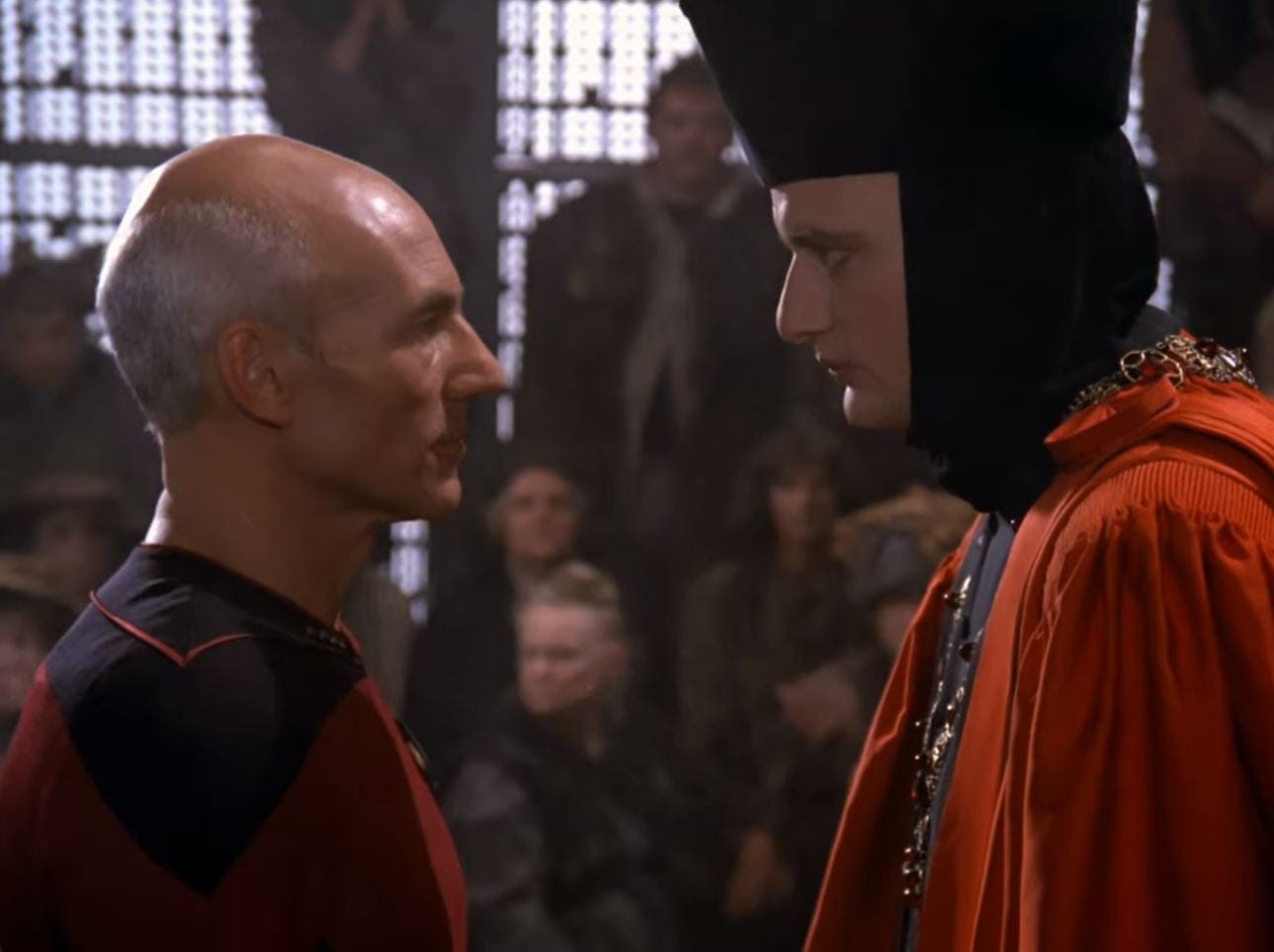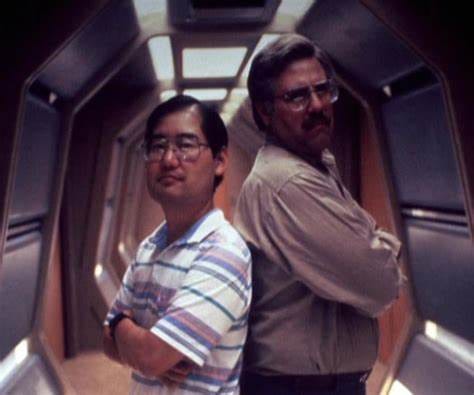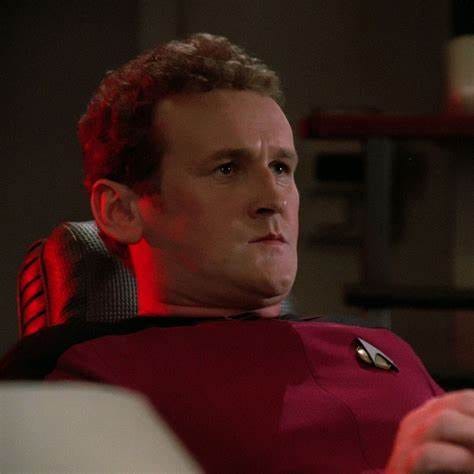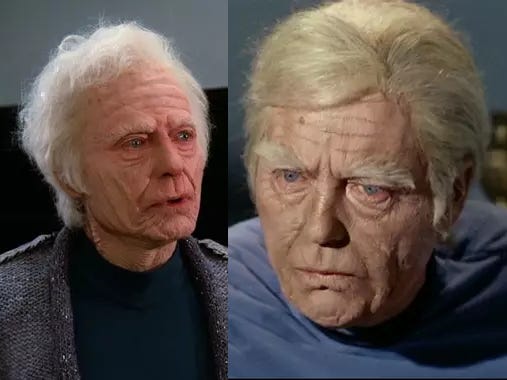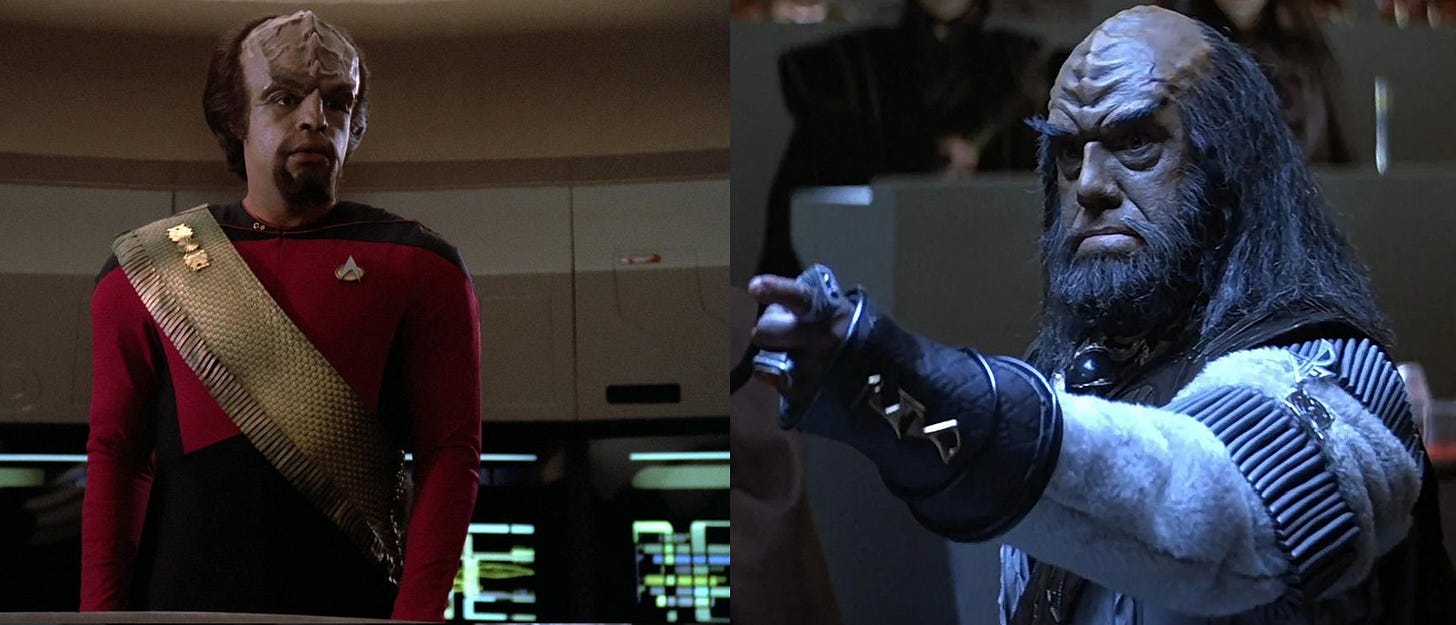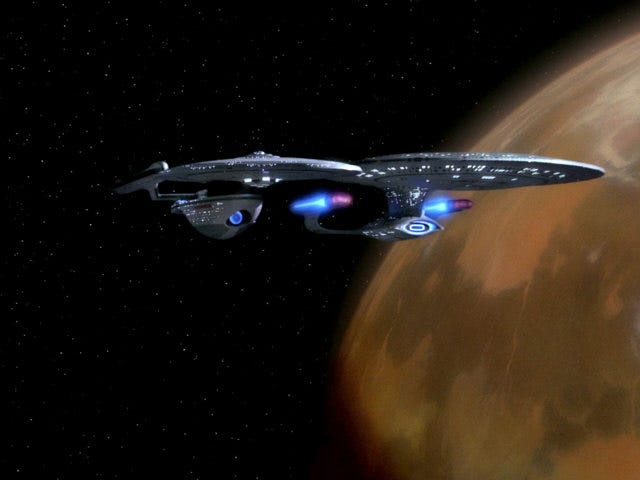Encounter at Farpoint, Part One
It's Star Trek... continued. No, really - we even put a god-like entity in the pilot!
The Enterprise-D's newly appointed captain is threatened by a bad CGI chain link fence in space - oh no! Whatever will he do... Why, engage in theatrical repartee with a god-like alien who has dropped by just to taunt him, of course! Good thing he has the help of an android ventriloquist, the worst security chief in Starfleet, and let's not forget walking thesaurus Deanna Troi to tell him how everyone feels. Meanwhile, Commander Riker is milling around in an unallied Starbase on the edge of known space with the Enterprise-D's conn officer, because nothing says 'good planning' like setting off into the galaxy without your helmsman. With them are the Chief Medical Officer and her fifteen-year-old son, since the perfect way to protect three reckless Starfleet officers is to keep a precocious teenager in a cardigan close by.
Words
The script of “Encounter at Farpoint” is all about one thing: establishing that this really is Star Trek. Gene Roddenberry's involvement isn't enough by itself, but having Dorothy "D.C." Fontana to back him up establishes a sense of continuity in the production. Roddenberry had been on a short leash since the eye-wateringly expensive Star Trek: The Motion Picture, and struggled for a long time to get the go ahead for a new TV show, but the immense success of Star Trek IV: The Voyage Home the previous year (which grossed $133 million on a production budget of $26 million) apparently helped him gain traction with Paramount’s bosses.
On screen, 'Starfleet' does a great deal of the work in making the connection with the original show, but not as much as 'Enterprise'... Roddenberry could have come up with a new ship name, but he absolutely depends upon nostalgia for the original series, and reusing the ship name plays into this in a big way. So does kicking off the episode with a slightly-updated version of Kirk's opening monologue, 37 words (we gained one through inflation) that tell us unequivocally 'this show is Star Trek... continued'.
One phrase that draws against classic Trek is particularly interesting: 'shields and deflectors up, sir!'. It’s Worf's very first line in the show, and a very unusual phrasing that by the end of the first season will be phased out entirely since 'deflectors' are about to become something rather different from the shields. In the writer's guide for the classic show (written after the first season) 'Deflector Screens' were the name for the shield system, which was only informally called a 'shield', although writers used 'shields' just as often as 'deflectors' - and sometimes combined them as 'deflector shields'. The lack of consistency isn't quite as relevant here as the fact that having coherent imaginary technology started to matter more and more after Star Trek: The Next Generation, and that's down almost entirely to two of the key technical staff: Rick Sternbach and Michael Okuda.
It's fair to say that until Sternbach and Okuda sat down and thrashed out canonical rules for how TNG shields work, the show's writers were still operating in the same woolly space that allowed Decker in Star Trek: The Motion Picture to say "Recommend defensive posture, Captain: Screens and shields," a statement that has mobilised fans to all sorts of interesting retconnery and fanonising in order to make sense of it. I love that we do this... but the explanation for this and so many other inconsistencies is that writers only borrow the technobabble for narrative reasons and don't ever truly understand it - certainly not in the way that fans do. There is no logically consistent world in which all these contradictory statements make sense, there's only the scripts and the circumstances behind them. It is we, the fans, who force it all to make sense.
Acting Roles
It's all about Patrick Stewart's Picard sparring with John de Lancie's Q, and goodness knows they completely rescue this episode, and perhaps the entire show and franchise too. This was a pilot episode, after all, and it needed to be a big win to secure the audience. That said, since the show launched into syndication (an incredibly unusual situation) it was not quite as vulnerable to a bad pilot as other network TV shows.
Riker's arrival in Act IV, with LaForge and Dr Crusher along for the ride, has Wesley achieving hitherto unconsidered peaks of annoying right from the outset. In an inspired moment of peak insanity, Riker gets to catch up what happened in his boss' story arc by watching a repeat of the three Acts we just finished watched, which isn't even the most completely bizarre thing to happen in the episode.
Shout-out to the brilliant Colm Meaney as... erm... Battle Bridge Conn. A brilliant but obscure character actor, Meaney must be on set just for the paycheque, because he has precious little to do here. Although we will see him again in season one, he doesn't get a permanent job role for another twenty episodes, requires six more episodes to earn a surname, and a further forty-two before getting his forename in season four's “Family”.
And then of course, there's DeForest Kelley, reprising his role as 'Old Bones' from the classic Trek episode “The Deadly Years”, with largely identical make-up (apparently by intent). Did we forget to mention that this show is Star Trek... continued? Well don't worry, because we've got several more episodes belabouring this point still to come.
Models, Make-up, and Mattes
But it's not Kelley's make-up but Worf's Klingon forehead that deserves special mention in the latex department. This only looks poor to us these days because we've become accustomed to the more elaborate Klingon make-up designs that came later. It's on a par with what we were seeing in the Star Trek movies at this time, and that's quite an achievement on a TV show budget.
The special effects star of this show, however, is the six-foot model of the Enterprise-D. So vital is the six-foot Enterprise model to the episode that it gets an absolute ton of screen time - especially in the never-tedious saucer separation sequence, which is painstakingly slow. As fans have repeatedly pointed out, this was never a very clever tactic in the first place. When exactly is it going to make sense to take all the families and leave them in the least defended, slowest part of the ship...?
Nonetheless, the model and the miniatures work by George Lucas' Industrial Light and Magic is cinema-quality, even if the CGI chain link fence leaves a lot to be desired, having aged rather badly.
Finally, a hat-tip to ILM for dusting off the 7.5-foot Excelsior model, built for Star Trek III: The Search for Spock, appearing here as the USS Hood, and as a billion other Excelsior-class vessels as the show goes forward. Seeing it alongside the more curvaceous body of the Galaxy-class Enterprise makes two clear points: we’re further along the timeline, but it is still the same world we’re looking at. It’s a brilliantly simple play to make us all believe that this is indeed Star Trek… continued.



